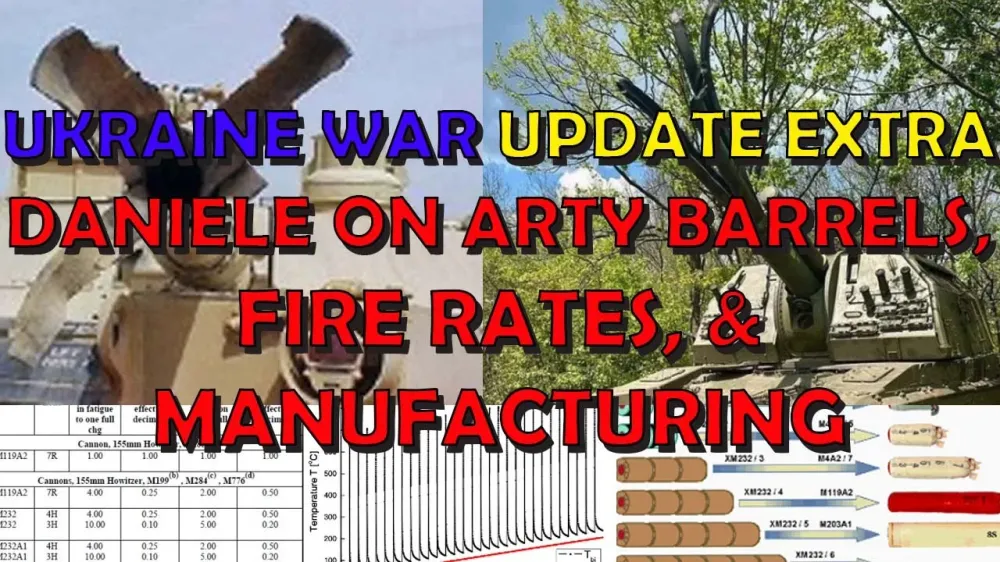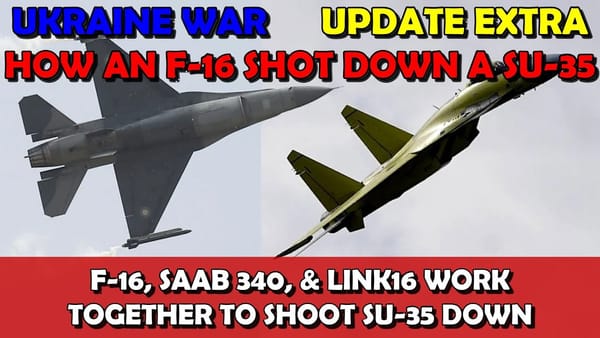Ukraine War Upd. EXTRA: Deniele on Artillery Barrels, Fire Rates, and Manufacturing
Table of Contents 📖
"In the end, the capability of the tear for an aggression comes to that. It's an insurance for the future generation to be kind of safe. Because we need to understand, I mean, I don't like war. I like weapons, I like as a system. I like guns as a system because I love engineering engineering as you can imagine from my avatar. But the problem is that, I mean, one of the most powerful phrases of Zelensky was democracy has to be better harmed than tyranny. And I think this is very powerful and has all the meaning of this."
Hello Team
🎦 00:01-01:02⏩
Jonathan welcomes viewers to a new Ukraine War Update EXTRA video and introduces Daniela from Tochnyy as a guest. He explains that Tochnyy reports the war from an objective viewpoint, focusing on data and information to avoid misinformation.
Return to top⤴️
Daniela’s introduction
🎦 01:03-01:37⏩
Daniela thanks Jonathan for inviting her and shares that Tochnyy is committed to providing unbiased and trustworthy news, particularly about the war in Ukraine. She highlights their focus on double-checking information and the recent publication of long-form content that involved the entire team.
Return to top⤴️
Daniela’s work on FPV drone and gun barrel threads
🎦 01:37-02:36⏩
Daniela explains that she collaborated with Andrew Perpetua on an FPV drone thread and with both Andrew and Jonathan Ridge on the gun barrel thread. She mentions that Jonathan Ridge contributes to Andrew’s live streams, while Jonathan is a key figure in Tochnyy.
Return to top⤴️
Daniela’s motivations and approach
🎦 02:36-03:35⏩
Daniela shares that she was motivated to create a gun barrel thread after seeing Andrew Perpetua’s data. Her goal was to analyse the data and identify any trends, approaching the topic with an unbiased perspective. She developed a code to analyze Andrew’s data and interpreted the results as they were, without preconceived notions.
Return to top⤴️
Discussion on gun barrel importance
🎦 03:35-05:19⏩
Jonathan highlights the importance of gun barrels for maintaining artillery, which he describes as "the god of the war". He mentions the ongoing discussions about artillery ammunition and the desire to understand how many barrels Russia has. He also raises concerns about the time it takes to manufacture barrels and the potential impact on both Russian and Ukrainian forces.
Return to top⤴️
Signalling Russian Barrel Problems
🎦 05:19-08:29⏩
Daniela notes that several signs suggest Russia is facing significant barrel issues. She mentions the deployment of T-54 and T-55 tanks, which initially drew ridicule but were likely used for indirect fire due to Russia's shortage of lighter guns. She also cites reports from OSINT accounts suggesting chaotic movement and depletion of self-propelled and towed artillery pieces in Russian depots.
Return to top⤴️
Barrel challenges for both sides
🎦 08:29-09:39⏩
Daniela acknowledges that both Russia and Ukraine face barrel challenges due to the high rate of artillery fire. She highlights the advantage of NATO in terms of procuring and producing barrels but emphasizes that restarting production is a significant challenge. Jonathan adds that Covert Cabal has been tracking Russian artillery and tank depots, attempting to assess the sustainability of their supply lines and equipment replacement.
Return to top⤴️
Russian firing rate and maintenance
🎦 09:39-10:36⏩
Jonathan shares reports that Russia has been firing up to 60,000 shells a day, compared to Ukraine's 2,000. He suggests that Russia's barrel problems are magnified by this high firing rate, especially given the age and potential lack of maintenance of their older artillery pieces. He notes that even if the maintenance schedules are similar, Russia is firing five times more rounds, leading to increased wear and tear and barrel failures.
Return to top⤴️
Barrel maintenance and refurbishment
🎦 10:36-11:33⏩
Daniela mentions that M777 howitzers have been shipped back to Poland for refurbishment, a strategy employed to avoid targeting the guns and maintain their operational capability. Jonathan points out that the success of this approach has been limited, which he attributes to the careful maintenance of information regarding gun locations.
Return to top⤴️
Russian logistical challenges
🎦 11:33-12:23⏩
Daniela argues that Russia's logistical problems stem from their reliance on a large, but poorly maintained, army. Their logistical capabilities are stretched, limiting their combat effectiveness despite their numerical advantage.
Return to top⤴️
Ukrainian logistical advantages and risks
🎦 12:23-12:53⏩
Daniela highlights the Ukrainian advantage of fighting closer to their supply lines, allowing them to maintain a higher quality of supply. She also acknowledges the risk of Ukrainian supply lines being targeted by Russian forces, as evidenced by Andrew Perpetua's daily updates on destroyed vehicles.
Return to top⤴️
Shifting Ukrainian targeting strategy
🎦 12:53-14:01⏩
Jonathan explains the shift in Ukrainian targeting strategy, moving from focusing on frontline defenses to targeting Russian logistics. This change is intended to undermine Russia's ability to sustain their forces, ultimately leading to their attrition.
Return to top⤴️
Manufacturing challenges for Russia
🎦 14:01-15:26⏩
Daniela discusses Russia's challenges in procuring new barrel-manufacturing machines, as they are barred from buying from European manufacturers, who are considered global leaders in rotary forging. She believes they will turn to China for new equipment, but acknowledges that setting up facilities, training personnel, and verifying production processes will take time, questioning whether Russia has this time.
Return to top⤴️
Wars and manufacturing capacity
🎦 15:26-16:24⏩
Jonathan highlights the importance of manufacturing capacity and financial resources in determining the outcome of wars. He emphasizes that Russia's GDP is significantly less than that of allied nations combined, suggesting they cannot win the war unless China gets heavily involved. He also acknowledges that Russia has access to Iranian and North Korean weaponry, but questions the sustainability of these supply chains.
Return to top⤴️
Europe's manufacturing capacity and political will
🎦 16:24-17:07⏩
Daniela points out that comparing GDPs does not account for the nations at war. She notes that Europe alone could outpace Russia but only with a strong political will, a factor that concerns her and the defense industry.
Return to top⤴️
European vs. US defense industry models
🎦 17:07-18:37⏩
Jonathan and Daniela discuss the differences in European and US defense industry models. He explains that European defense companies are predominantly private entities, relying on contracts and investment to sustain their operations. In contrast, the US has a more state-controlled model, with government ownership of key manufacturing plants and a more flexible approach to production.
Return to top⤴️
State-owned vs. private industry models
🎦 18:37-20:39⏩
Jonathan further explores the advantages and disadvantages of state-owned vs. private industry models in terms of ammunition production. He notes that while private companies are often more dynamic, state-owned facilities in the US have a clear advantage due to government ownership, allowing them to prioritize production without strict contract or capital requirements. He contrasts this with European manufacturers, who are more hesitant to ramp up production without long-term contracts and investment guarantees.
Return to top⤴️
Political will and funding in European defense
🎦 20:39-22:35⏩
Jonathan emphasizes the importance of political will and government commitment in supporting European defense industries. He highlights the requirement for government contracts and approval to fund production, creating a dependence on political decisions and financial support. He also notes that private companies, like BAE, must prioritize profit margins, potentially leading to higher costs and reluctance to undertake projects without guaranteed returns.
Return to top⤴️
The need for state involvement in defense
🎦 22:35-23:36⏩
Jonathan argues that some industries, like defense and healthcare, cannot be fully privatized because they require state involvement to ensure vital services are maintained, even if it means accepting potential financial losses. He emphasizes that the cost of Russia's invasion outweighs the potential costs of increased defense investment, advocating for a more proactive approach to deterrence.
Return to top⤴️
Defense spending analogy
🎦 23:36-24:49⏩
Jonathan uses the analogy of insurance to illustrate the importance of defense spending. He argues that just as people pay for car insurance to protect themselves from financial hardship in case of an accident, nations should invest in defense to prepare for potential conflicts. He emphasizes that inadequate defense spending can lead to significant financial burdens and inadequate preparedness when faced with a crisis, like the Ukraine war.
Return to top⤴️
The need for defense capabilities in a democracy
🎦 24:49-26:45⏩
Daniela highlights the importance of defense capabilities for democracies to deter aggression from tyrannical regimes. She acknowledges that while she dislikes war, she values weapons as engineering systems. She draws on Zelensky's statement that "democracy has to be better armed than tyranny" to support the need for strong military capabilities to protect against oppressive forces.
Return to top⤴️
The importance of defense investment
🎦 26:45-27:33⏩
Jonathan reinforces the need for defense investment, emphasizing that inadequate preparedness can have dire consequences, as exemplified by the COVID-19 pandemic. He highlights the critical shortage of PPE for healthcare workers due to insufficient investment, despite warnings from scientists. He connects this to the current situation, highlighting the global impact of the war on prices and production, creating a similar situation to the pandemic-driven surge in demand for essential medical supplies.
Return to top⤴️
Western equipment and propaganda
🎦 27:33-29:11⏩
Daniela addresses the false propaganda that Western equipment is inferior or over-engineered. She argues that such claims are motivated by an attempt to discredit Western capabilities and justify underinvestment. She cites the example of the F-35 fighter jet, which has been subject to numerous false criticisms. She emphasizes that falsehoods spread more quickly than truths on social media, making it difficult to counter misinformation effectively.
Return to top⤴️
Barrel wear and tear
🎦 29:11-32:55⏩
Daniela explains the process of barrel erosion and fatigue caused by repeated firing. She details the impact of projectile movement, rifling, and the corrosive gases produced by propellants on the barrel's lifespan. She highlights the use of protective coatings, like chromium, to extend the barrel's life by reducing corrosion and wear. She also explains that barrel fatigue can lead to micro-fractures over time.
Return to top⤴️
Estimating barrel life and EFC
🎦 32:55-44:55⏩
Daniela discusses the industry's approach to estimating barrel life, noting that it's difficult to determine the exact number of shots a barrel can sustain due to variations in firing missions and propellant charges. She references a table from the 2016 US Army artillery book that lists the different charges available and their impact on barrel wear. She explains that each charge consumes a specific amount of "Effective Fire Charge" (EFC), which represents the barrel's life expectancy. She demonstrates how to use the table to estimate the amount of EFC consumed based on the types and quantity of charges used in a firing mission.
Return to top⤴️
Understanding EFC and barrel life
🎦 44:55-48:16⏩
Jonathan and Daniela clarify the concept of EFC and its relation to barrel life. They emphasize that 2,500 EFC is the maximum achievable value, and different barrels and charges can have varying impacts on EFC consumption. They further illustrate the calculation of EFC consumption with a specific example. Jonathan also mentions the M666 barrel, used in the M777 howitzer, which provides insight into the typical consumption of EFC.
Return to top⤴️
Historical comparisons and barrel life
🎦 48:16-49:40⏩
Daniela debunks the misconception that older artillery barrels were more durable. She points out that the Long Tom, a high-performing howitzer from World War II, could only fire about 1,500 shells, significantly less than modern artillery. She emphasizes that historical comparisons must consider the operating environment and technological advancements, as modern artillery is designed for mobility and responsiveness in a drone-enabled battlefield.
Return to top⤴️
Conclusions on barrel performance and needs
🎦 49:40-50:55⏩
Daniela concludes that the barrels provided by Western nations are performing well, but the need for more remains. She notes that production of M777 barrels has been suspended due to the contract ending a few years ago, suggesting that they are being drawn from existing stockpiles.
Return to top⤴️
Future of artillery and replacement strategies
🎦 50:55-51:33⏩
Jonathan discusses the ongoing debate surrounding the future of towed artillery and the planned replacement with self-propelled howitzers and systems like HIMARS. He acknowledges that towed howitzers still have a role, particularly for airborne units. However, he suggests that the war in Ukraine may necessitate a re-evaluation of the role of towed artillery, as it has proven effective on a larger scale than anticipated.
Return to top⤴️
Manufacturing times and challenges
🎦 51:33-55:09⏩
Jonathan and Daniela discuss the significant time required to manufacture artillery barrels, highlighting the need for greater production capacity to meet the demands of the war. They explain that the process involves multiple parts and stages, requiring dedicated factory lines, personnel, and potential investment in automation to speed up production. They emphasize that maintaining peacetime production levels would be insufficient in a conflict, necessitating a shift in approach to meet urgent needs.
Return to top⤴️
Barrel procurement challenges for Ukraine
🎦 55:09-57:31⏩
Jonathan questions whether Ukraine or Russia is in a better position to procure and maintain barrels. He acknowledges that Western nations, particularly the UK and US, have strong barrel manufacturing capabilities, with companies like Raymetal and BAE playing a key role. He notes that BAE's presence in the US also creates incentives for the US to invest in barrel production. He emphasizes that the war in Ukraine is prompting a re-evaluation of warfare strategies and prompting investments in new technologies to improve efficiency and production times.
Return to top⤴️
US and NATO learning from the war
🎦 57:31-58:26⏩
Jonathan highlights the learning process underway in the US and NATO, as they observe and analyze the war in Ukraine. He points out that the UK is revising its military strategy, and that the war has prompted a reassessment of procurement priorities, as evidenced by the UK's significant investments in a large drone program that appears obsolete in light of the effectiveness of smaller drones in Ukraine. He emphasizes that Ukraine's experiences are shaping the future of warfare.
Return to top⤴️
Ukraine's learning curve
🎦 58:26-59:29⏩
Daniela highlights Ukraine's rapid learning curve on the battlefield, noting their adaptation and utilization of Western equipment. She acknowledges her involvement in fundraising and interacting with Ukrainian soldiers who are gaining invaluable experience in combat, both in Ukraine and through previous deployments in the UK and US militaries. She emphasizes that Ukraine's current arsenal is among the best available, with areas like electronic warfare and communication remaining essential for future success.
Return to top⤴️
Ukraine’s use of Bradley and electronic warfare
🎦 59:29-01:01⏩
:20
Jonathan highlights the impressive adaptation of Bradley infantry fighting vehicles by Ukrainian forces, showcasing their effectiveness in urban environments and support operations, contrasting with the initial use in minefield clearance. He acknowledges that electronic warfare capability is a key area where Ukraine needs significant improvement.
Return to top⤴️
The effectiveness of cheap drones
🎦 01:01:20-01:01⏩
:48⏩
Jonathan emphasizes the cost-effectiveness of cheap drones in combat, noting that they have been able to disable or destroy expensive military vehicles. He cites examples of $300-$400 drones effectively neutralizing tanks.
Return to top⤴️
US expertise and limitations in electronic warfare
🎦 01:01:48-01:01⏩
:55⏩
Jonathan acknowledges the US's leadership in electronic warfare but highlights the reluctance to share this sensitive technology with Ukraine. He suggests that the US prioritizes retaining control over intellectual property, particularly in the field of electronic warfare.
Return to top⤴️
The need for electronic warfare in Ukraine
🎦 01:01:55-01:03⏩
:14⏩
Jonathan emphasizes the urgent need for electronic warfare capabilities in Ukraine, particularly to protect vulnerable supply routes like the Dnipro River crossings from drone attacks. He highlights the effectiveness of the Ukrainian forces on the left bank of the Dnipro River in mitigating Russian airstrikes but expresses concern about the lack of electronic warfare support to further reduce the impact of attacks.
Return to top⤴️
Ukrainian success and the need for more support
🎦 01:03:14-01:04⏩
:27⏩
Jonathan highlights the Ukrainian success in mitigating Russian airstrikes through the use of Patriot missile systems and defensive strategies. He suggests that providing Ukraine with more advanced electronic warfare capabilities could offer targeted protection, such as safeguarding supply boats on the Dnipro River. He acknowledges the limitations of their ability to provide this support but emphasizes the importance of protecting the Ukrainian forces on the left bank of the Dnipro River.
Return to top⤴️
Daniela’s concluding thoughts
🎦 01:04:27-01:05⏩
:37⏩
Daniela summarizes her findings, highlighting the effectiveness of the artillery systems provided by Western nations. She mentions that Ukrainian forces have shown a preference for Krabs, AS90, and Aces, but emphasizes that they will utilize whatever equipment is supplied. She also notes that while the Paladins were not favored, she is unsure why.
Return to top⤴️
The AS90 and the Crab
🎦 01:05:37-01:06⏩
:27⏩
Jonathan and Daniela discuss the AS90 and the Crab howitzers, confirming that they are essentially the same system. Daniela explains that the Crab is a South Korean-Polish co-production based on a South Korean design but with a British Braveheart turret, similar to the AS90.
Return to top⤴️
Preferences for AS90 and Crab
🎦 01:06:27-01:07⏩
:24⏩
Jonathan inquires about the reason for Ukrainian preference for the AS90 and Crab, suggesting that it might be due to the chassis being superior to the K9 Thunder. Daniela acknowledges the popularity of the AS90 and Crab but doesn't have a definitive answer, referencing conversations with friends who have noted the preference.
Return to top⤴️
The unpopularity of the Paladin
🎦 01:07:24-01:08⏩
:01⏩
Jonathan and Daniela discuss the reasons behind the unpopularity of the Paladin, a US howitzer. Daniela mentions that Andrew has confirmed this observation but doesn't know the reason, speculating that Andrew might have more information. She cites rumors about the Paladin's poor drivability and tendency to flip over, although she acknowledges its overall capability and the challenging combat environment where it is being used.
Return to top⤴️
Concluding thoughts
🎦 01:08:01-01:09⏩
:43⏩
Jonathan and Daniela reiterate their conclusion that the artillery systems supplied by Western nations are performing well. However, they emphasize the need for more artillery and ammunition, particularly considering the high rate of fire and the challenges associated with restarting barrel production.
Return to top⤴️
Capabilities of Western artillery systems
🎦 01:09:43-01:10⏩
:41⏩
Daniela highlights the technological capabilities of Western artillery systems, emphasizing that they are not merely expensive toys designed to inflate budgets. She mentions that the PH2000 features a barrel sensor for data analysis, which allows operators to detect potential issues. She notes that while some systems, like the PH2000, are not intended for sustained high-rate fire, they are still highly effective for precision strikes and guided munition usage.
Return to top⤴️
Western doctrine and the Cold War
🎦 01:10:41-01:11⏩
:45⏩
Jonathan and Daniela discuss the evolution of Western military doctrine, influenced by the Cold War era. He explains that the focus on precision strikes and electronic warfare was driven by the need to overcome Soviet numerical superiority. He highlights the importance of precision in minimizing casualties and collateral damage, as well as the need to effectively counter a large enemy force with limited resources.
Return to top⤴️
The importance of precision and quality
🎦 01:11:45-01:12⏩
:48⏩
Jonathan and Daniela emphasize the importance of sending high-quality equipment to Ukraine. They argue that providing outdated or inferior equipment could lead to unnecessary casualties and undermine the effectiveness of Ukrainian forces. They highlight the Ukrainian focus on preserving their limited manpower, especially when compared to the large reserves available to Russia.
Return to top⤴️
NATO’s Cold War doctrine and precision strikes
🎦 01:12:48-01:13⏩
:27⏩
Jonathan discusses NATO's Cold War doctrine, which emphasized precision strikes and electronic warfare due to the significant numerical advantage of the Soviet Union. He mentions a NATO exercise where the primary strategy for countering a Soviet tank assault involved nuclear strikes due to the overwhelming threat posed by Soviet armored forces. He underscores that Western military doctrine has always been based on fighting against a numerically superior opponent.
Return to top⤴️
The evolution of Western military doctrine
🎦 01:13:27-01:14⏩
:15⏩
Jonathan highlights the evolution of Western military doctrine, influenced by conflicts in the Balkans and Iraq. He notes that concerns about collateral damage and civilian casualties have led to greater emphasis on precision strikes and reducing unintended consequences. He points out the effectiveness of weapons like Storm Shadow in targeting specific targets without causing significant damage to surrounding areas.
Return to top⤴️
The importance of public relations in warfare
🎦 01:14:15-01:14⏩
:39⏩
Jonathan acknowledges the importance of public relations (PR) in modern warfare. He suggests that while Russia, being a dictatorship, is less concerned about PR backlash, democracies must consider the political and public ramifications of their actions. He emphasizes that weapons should be designed with PR considerations in mind to minimize civilian casualties and maintain public support.
Return to top⤴️
Storm Shadow and Russian munitions
🎦 01:14:39-01:15⏩
:01⏩
Jonathan contrasts the design and usage of Storm Shadow missiles with Russian munitions. He highlights the built-in safety features of Storm Shadow, which allow it to self-destruct in a designated safe zone if it fails to hit its target. In contrast, he suggests that Russian munitions lack such safety measures and are used with less regard for collateral damage.
Return to top⤴️
The need for continued Storm Shadow production
🎦 01:15:01-01:15⏩
:34⏩
Jonathan expresses concern about the suspension of Storm Shadow production, suggesting that it is a mistake. He notes that while the UK has a replacement program, it is not expected to be operational until 2026. He highlights the need for a readily available supply of this effective weapon system.
Return to top⤴️
The Stinger missile and production challenges
🎦 01:15:34-01:16⏩
:57⏩
Jonathan shares information about the Stinger missile, which was also out of production before the war in Ukraine. He highlights the significant time it took to restart production and the challenges associated with restarting manufacturing lines and retraining personnel. He mentions that the Stinger's manual assembly also limits production capacity.
Return to top⤴️
Political considerations and Storm Shadow production
🎦 01:16:57-01:17⏩
:58⏩
Jonathan explains that the lack of Storm Shadow production is primarily a political issue. He suggests that a decision needs to be made to restart production and place an order for additional missiles, as the existing factories are currently inactive. He believes that Europe should consider increasing its stockpile of Storm Shadow missiles given their effectiveness and the potential for future conflicts.
Return to top⤴️
SUNAC’s promise of long-range missiles
🎦 01:17:58-01:18⏩
:13⏩
Jonathan mentions that SUNAC has promised the supply of long-range missiles to Ukraine, but it is unclear whether these will be maritime missiles or additional Storm Shadows.
Return to top⤴️
The need for a large order to restart Storm Shadow production
🎦 01:18:13-01:18⏩
:49⏩
Jonathan reiterates that restarting Storm Shadow production would require a substantial order, potentially involving contributions from France, Italy, and potentially Germany. He notes that this would be necessary to justify the investment and the reestablishment of the production lines.
Return to top⤴️
Polish purchases of the Piorun man-portable air-defense system
🎦 01:18:49-01:19⏩
:16⏩
Jonathan mentions that Poland purchased a large number of Piorun man-portable air-defense systems in 2022. He speculates that these purchases were likely intended for Ukraine, as the US has ordered a significant number of Pioruns while also providing them to Ukraine.
Return to top⤴️
Wrap up
🎦 01:19:16-01:22⏩
:20⏩
Jonathan concludes the episode, thanking Daniela for her insights and encouraging viewers to follow Tochnyy on YouTube and Twitter. Daniela provides a closing message of "Slava Ukraini". Jonathan reiterates the importance of subscribing, liking, and sharing his videos and encourages viewers to follow his future content.
Return to top⤴️



